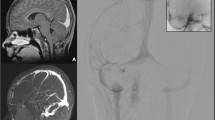Abstract
The aetiopathogenetic role of sinus venous obstructions carried by most idiopathic intracranial hypertension (IIH) patients is controversial. We report the case of a young woman diagnosed with IIH with papilloedema and narrowing of transverse sinuses, in which lowering of intracranial pressure by a single 20 ml cerebrospinal fluid (CSF) resulted in a strong dimensional increase of the transverse sinuses. Changes were followed by clinical remission and normalisation of optical nerve calibre, maintained after a 2-month follow-up. Our findings indicate that, although secondary to CSF hypertension, venous sinuses compression may have an important role in hypertensive status maintenance. Pathogenetic implications of venous sinus compression by hypertensive CSF in IIH are discussed.
Similar content being viewed by others
Author information
Authors and Affiliations
Corresponding author
Rights and permissions
About this article
Cite this article
De Simone, R., Marano, E., Fiorillo, C. et al. Sudden re-opening of collapsed transverse sinuses and longstanding clinical remission after a single lumbar puncture in a case of idiopathic intracranial hypertension. Pathogenetic implications. Neurol Sci 25, 342–344 (2005). https://doi.org/10.1007/s10072-004-0368-3
Received:
Accepted:
Issue Date:
DOI: https://doi.org/10.1007/s10072-004-0368-3




